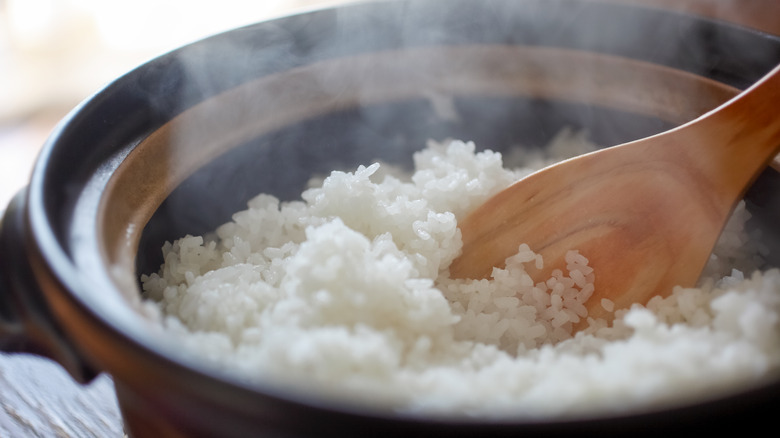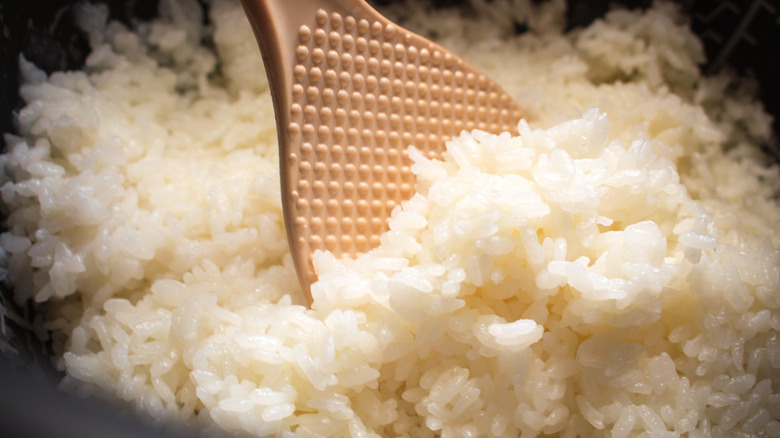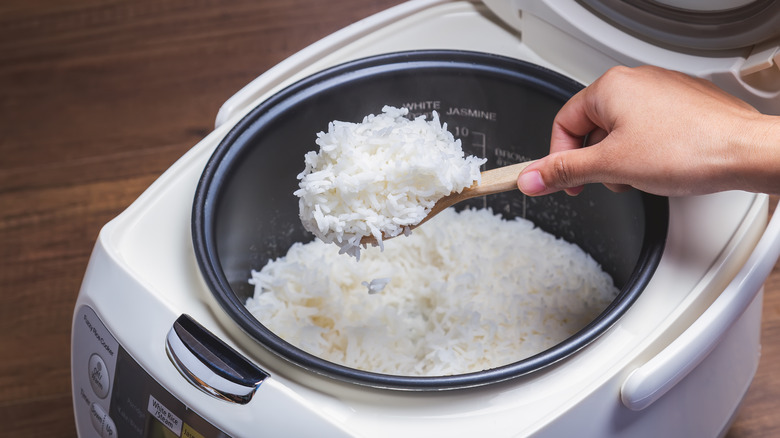Stirring Rice Is A One Way Ticket To Disappointing Texture
The act of preparing rice, which appears to be a simple process using just two ingredients, is a routine for an estimated 3.5 billion people around the world. Yet, without the proper techniques, the grain can end up mushy, gummy, hard, or burnt. There are many misconceptions about preparing the different varieties of rice: Whether to follow packaging directions, your mother's instructions, or listen to your favorite cooking personality, so here are some guidelines for making rice perfect every time to end all debates.
There are over 40,000 types of rice that fall into three categories: Long, medium, and short-grain. Short-grain rice has a high starch content, ideal for sushi, paella, and rice pudding. Varieties such as Bomba produce sticky rice that clumps together and holds its shape.
Slightly less starchy, medium-grain rice produces a creamier dish. Varieties such as Italian Carnaroli and Arborio are slowly cooked and used to make risotto, while Japonica rice is commonly eaten in Korea, Japan, and China.
Long-grain rice like basmati, Carolina Gold, and jasmine vary in appearance and aroma. Yet, when made correctly, this rice type should be al dente and fluffy with noticeably individual grains.
Factors such as whether to rinse the rice before cooking, the water-to-rice ratio, cooking method, and cooking temperature vary and affect its texture. However, except for medium-grain, rice should not be stirred while cooking. Just like searing meat, keep your hands off until it's done.
Stirring leads to uneven cooking
Grains of rice are delicate, especially while rehydrating. Stirring rice during cooking can break the grains into pieces, leading to uneven cooking. Shorter, broken grains will end up overcooking, while the larger whole grains take longer to prepare, resulting in a half-gummy dish.
It's best to leave the dish alone until you think it's done unless the smell or sound indicates the temperature is too high, and it's burning. Even lifting the lid, and releasing the trapped steam, can affect the texture and dry out the rice, leaving you with undercooked or burnt pieces. If you must, taste a few grains or gently push the rice from the sides to see if there's still liquid on the bottom. Unlike other uses of medium-grain rice, risotto preparation demands constant attention and frequent stirring. This action is necessary for releasing the starches from the rice, which ultimately produces the creamy texture that is characteristic of risotto.
While each type of rice has different characteristics, all varieties should be washed before cooking. Rinsing the rice removes impurities like dirt and excess starch, preventing a gummy texture or film from forming on the cooked rice. Since this process will affect the cooking ratio, measure the rice before rinsing, then place the grains in a fine mesh sieve and agitate them under cold running water. Continue this process until the water runs clear.
Different cooking methods
Rice can be cooked in several ways — the classic method, in a rice cooker, or boiled like pasta. The type of rice and how you cook it determines the proper water-to-rice ratio. Although brown rice looks like a darker version of long-grain white, it requires more water and a longer cooking time, so reading the manufacturer's directions is essential.
When cooking rice in the classic stovetop method, bring the suggested ratio of water and rice to a boil, generally two-part water to one-part rice. Lower the heat to a simmer and place a tight-fitting lid on the pot. The rice should take between 18 and 30 minutes to cook, depending on the variety. Allow the pot to sit off the heat for a few minutes, covered, to absorb residual moisture in the pot before fluffing the grains with a fork.
Rice cookers are foolproof and require less water than the classic method. Refer to the manufacturer's recommendations for measurements, as some models suggest an even water-to-rice ratio. Too much water will result in gummy, mushy rice, and too little will leave you with hard or burnt grains.
Although less popular than the other methods, rice can also be cooked like pasta, which is a good solution if you are unsure about the correct water-to-rice ratio or making a giant batch. Boil the rice in plenty of water, stirring frequently until al dente, and then drain the rice through a fine mesh sieve.



